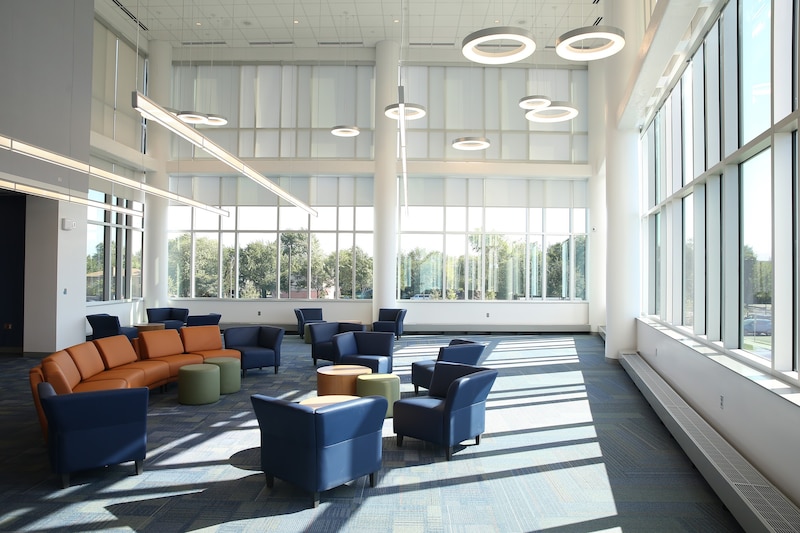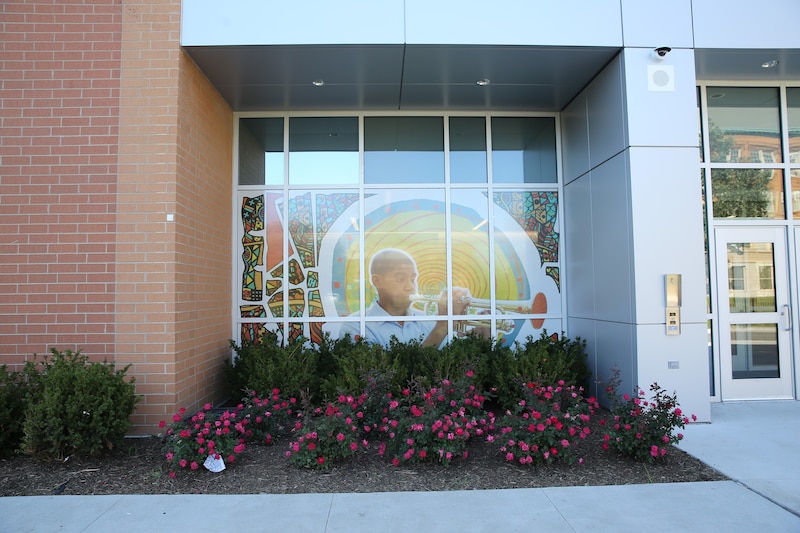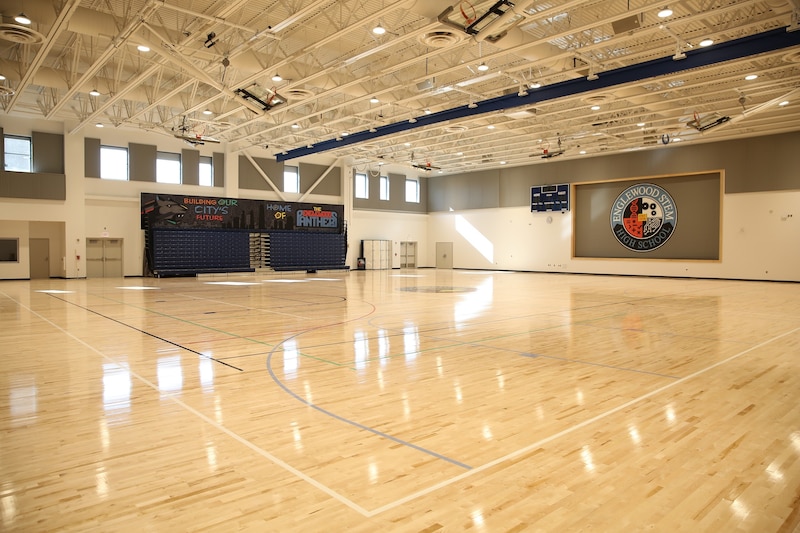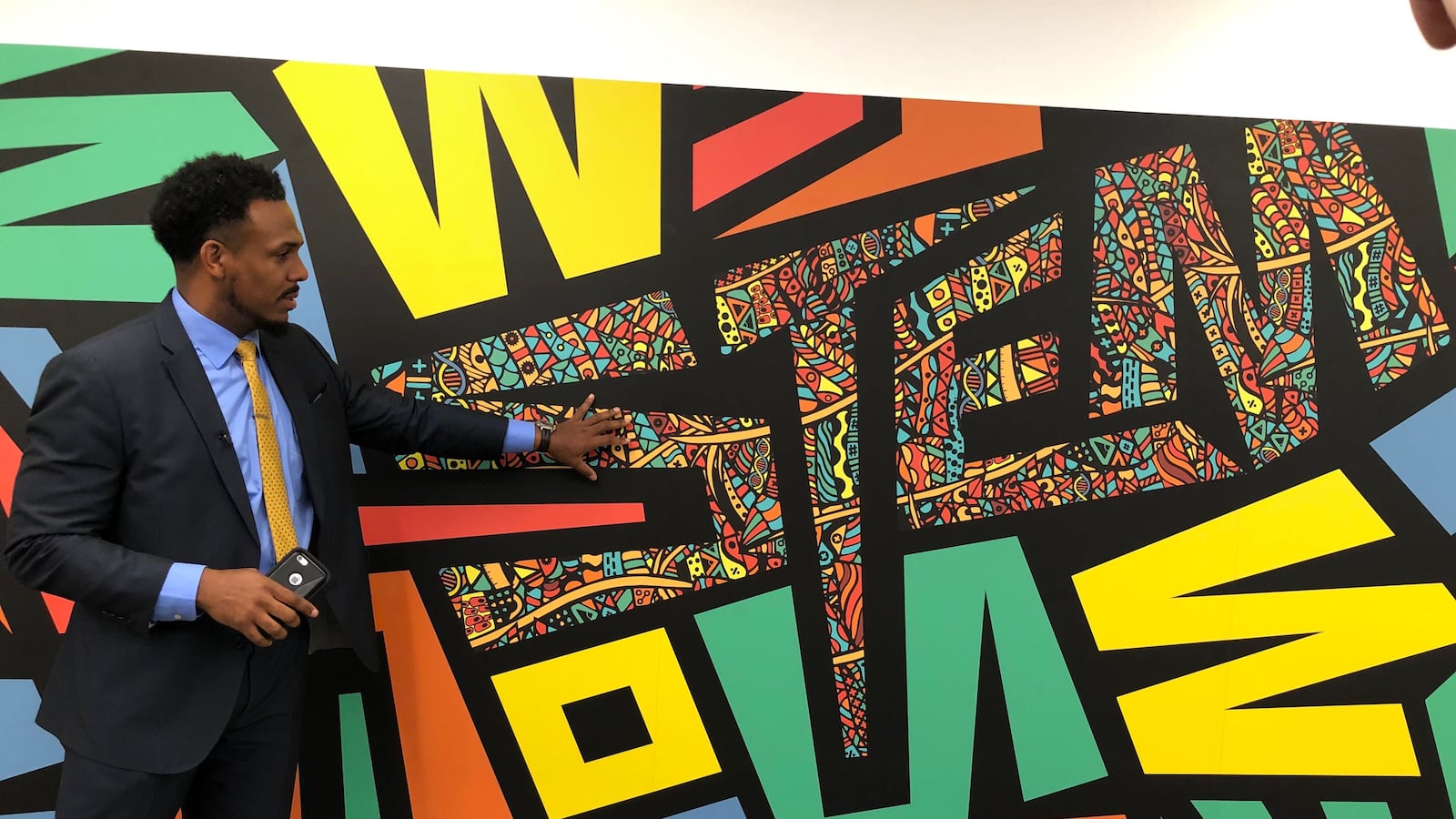Freshman Javia Tillery will walk through the doors of a brand new glass-and-steel building on Tuesday morning, the first day of school. Inside, the walls are freshly painted with murals featuring Afro-centric designs and young people of color dressed as doctors and scientists.
She will be one of more than 400 freshmen attending the $85 million Englewood STEM High School, the only new district-run school to open this year. It is situated on the city’s South Side, at the site of the former Robeson High School, which was demolished last summer.
The school marks two critical moments for the district: a shift toward consolidating campuses in neighborhoods where public schools have seen dramatic enrollment declines, and a chance to heal wounds left after decades of school closures and disinvestment in Englewood.
The career-preparation focus and the math, science, and engineering education sold Tillery on Englewood STEM. “I chose this school because everything, the curriculum, the teachers, seemed amazing,” she said.
She was originally slated to go to a district high school several miles away. But when Conrad Timbers-Ausar, principal of the STEM school, paid a visit to her middle school and spoke about the school’s focus on STEM and offered to let young people in the neighborhood vote on the school’s mascot, the Englewood resident decided to change course.
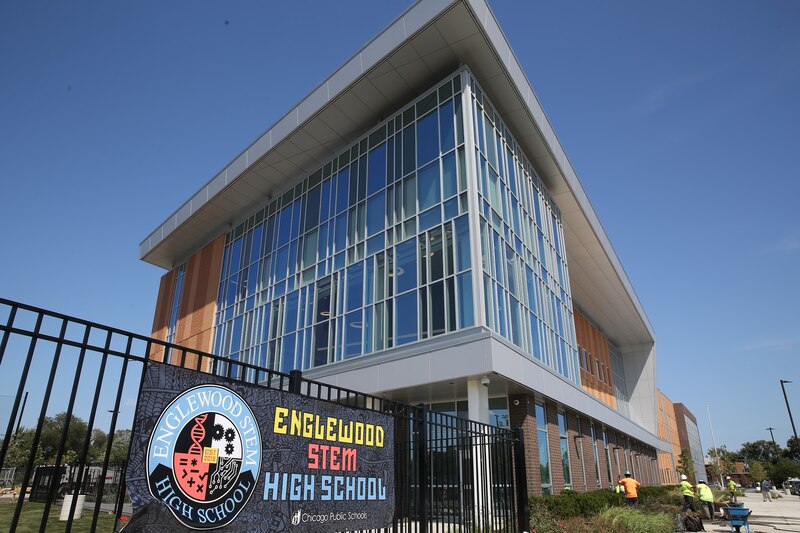
The new high school heralds a shifting approach as Chicago Public Schools student population has plummeted. In the past, the district used a formula to target for closure schools they considered under-enrolled — an approach often met with massive community pushback. Now district officials are trying an alternative to shuttering schools: beefing up neighborhood enrollment by offering newer, better-resourced schools in areas where students are travelling the most distance from their home schools, said schools chief Janice Jackson.
“I was early in my career having to make decisions about consolidations to bring this to fruition,” said Jackson during a press tour Thursday of the new building. “What Englewood represents is the path forward… It makes me encouraged we can do this for more kids around the city.”
Related: Can a new high school heal years of school closings in Englewood?
Since 2001, at least 16 public schools have closed in Englewood, most of them as part of the controversial Renaissance 2010 program Mayor Richard Daley began in 2004. Under that plan, the district aimed to close 100 low-performing schools city-wide and open new ones, including charters, in their place.
At the same time, the area was affected both by the city’s loss of black population and the foreclosure crisis, compounded by some of the highest rates of home demolition in the city. The district, meanwhile, continued to open charters, some of them even sharing space with schools that were seeing enrollment decline.
Fewer students meant less district funding, and less funding made schools less attractive to local families. They didn’t want to send their children to schools that couldn’t provide art or sports teams. As this was happening, the tide was turning against closings as a solution. A state law passed last year requires Chicago to consider other alternatives before closing schools, and community groups have held workshops to educate parents on other options for schools facing declining population.
The origins of Englewood STEM
Some community members told Chalkbeat that when they first heard about the plan to open a new school they were excited, but felt that they weren’t fully engaged in the initial process.
At the center of the efforts to shape the new school was a steering committee that drew heavily from members of the Englewood’s Community Action Council, or CAC, a body that meets regularly to oversee community decisions. The steering committee was charged with sending out surveys and soliciting community input on the school’s program offerings.
Timbers-Ausar, the school’s principal, visited elementary schools, went to neighborhood public events, and held open meetings to recruit students.
Related: Chicago is throwing its smallest high schools a lifeline. But is it enough?
Fewer than half of Chicago Public Schools students attend the school they are zoned for, and students in Englewood travel among the farthest distance to go to schools.
One measure of success for the new STEM school will be how many students it draws from Englewood itself. Students who live within the school’s attendance boundary will be admitted automatically, while others will go through a lottery.
So far, the school has received 1,500 applications for its about 400 spots for freshman. The district said the majority of Englewood STEM students are from the neighborhood, but did not say what percentage these students represent. Of the staff of the school, 63% of all staff including teachers are black, 21% are white, and 7% are Hispanic/Latino, according to district numbers; the teaching staff at the school is 59% black, 31% white, and 10% Hispanic/Latino.
When the school opens, students will have uniforms to help create an academic-focused culture, the principal said. Students will have access to computer and biology labs with the latest facilities, and the school will partner with local businesses and community colleges to give those enrolled real-world experience in STEM fields before they graduate.
Of the schools closed ahead of the STEM school opening, one was itself opened to replace a poorly performing school. Team Englewood Community Academy supplanted Englewood Academy High School, but closed its doors 12 years later.
Dori Collins, a member of the steering committee launched to support the school and the president of a company called District Outreach Initiatives, said that the district’s proposal for a new school aligned with the community’s longtime goal to have a quality neighborhood high school.
“They want to make sure that the excitedness and the support that is on the front end of the development of things will be sustainable,” said Collins, who said the district would need to sustain its investment to ensure the school’s success.
Related: Are there alternatives to closing schools? Chicago parents consider options.
Others noted that shiny new buildings don’t always mean improved educational outcomes. They also said that the resources poured into the school in Englewood only further highlight how under-resourced nearby schools continue to be.
Danielle Wallace, an Englewood parent and community activist, said one neighborhood elementary school had only just gotten up-to-date computers. “That seems crazy that we are just getting computers in a school in Englewood in 2019,” she said.
With Englewood home to a robust group of community organizations and outspoken activists, what happens at Englewood STEM is sure to be closely watched. Asiaha Butler, of the community group R.A.G.E. Englewood, was originally a member of the school’s steering committee but quit over concerns that it wasn’t serving all of the area’s needs and that the effort was too top-down. “Now that it is open and the dust is settled, I want to ensure that the thing promised and talked about does come to fruition,” she said.
Under district rules, the new school will not have a Local School Council until its third year. But the principal said there will be opportunities for community involvement through parent and student councils.
Englewood STEM is also considering some way to remember the legacy of the neighborhood schools that closed and to represent those schools’ alumni communities.
Timbers-Ausar connects this concept to a West African concept called ‘Sankofa.’ “It means to go back, to look back in order to move forward,” he said.
